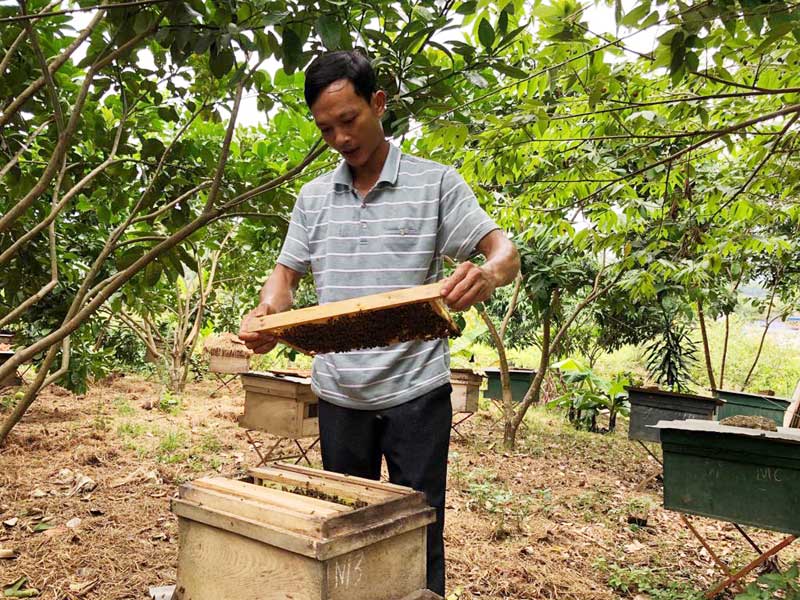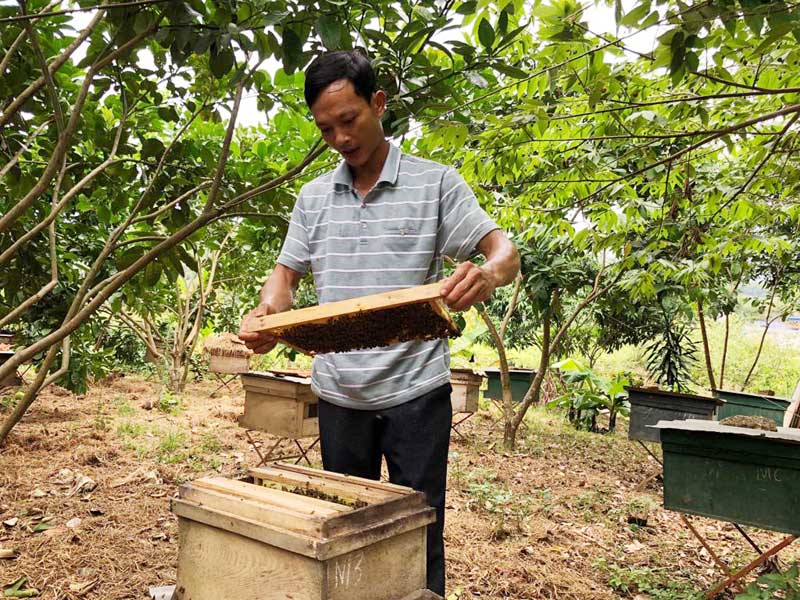
(HBO) – We were being so impressed when visiting the honey beekeeping model of Mr. Nguyen Van Tuoi in Sau Ha village, Thanh Luong commune.

Mr. Nguyen Van Tuoi, the leader of Sau Ha's
beekeeping cooperative group, Thanh Luong commune (Luong Son) is checking the
honey bee layer.
At the beginning time of bee raising, he kept
raising over 100 litters of bees. Then, the number has gradually increased to
200 - 250 litters per year. The food source of bees are trees, fruit trees
around the garden, acacia forest of the family. The nearby forests are also an
important food source for bees to look for food during almost four seasons. Mr
Tuoi said: On average, the family collects more than 1,000 liters of honey each
year. Honey of acacia is usually sold at 120,000 VND / liter, especially, honey
of longan with special taste, sweet taste is always favored by the market with
the higher prices, the average of 200,000 - 220,000 VND / liter; which makes
him get the income from 200 - 250 million VND / year.
In 2016, due to the demand of people with the
same bee keeping hobby in the village, Sau Ha's beekeeping cooperative group
was established with 5 members. Mr Tuoi was elected to be the leader of the
cooperative group. To be compared to the number of bee herds, Mr. Tuoi’s family
had the largest number of bee herds with 250 herds. The remaining households
maintain the number of bee herds from a few dozen or more. The second largest
bee keeping household is the family of Mr. Bui Van Rung with 90 herds. Mr Tuoi
shared: Since joining the cooperative group, every month and quarter, the
members of the group gather to exchange experience. In addition, when needed, the
members meet face-to-face or make a phone calls to help each other a lot in the
career development. The issues of common bee diseases, honey exploitation for
quality, best efficiency, market demand, prices, etc. are all being
enthusiastically supported and open by the members.
At present, Mr. Tuoi has supplied about 1,000
liters of honey to the market. In addition to honey production, he also has a
good income from bee breeding and bee-related supplies. His average annual
income is about 300 million VND.
After more than four years of implementing a project launched by the Hoa Binh Party Committee’s Standing Board on developing agriculture and promoting product consumption linked with building new-style rural areas for the 2021-2025 period, the province’s industry and trade sector has made significant strides, greatly contributing to local socio-economic development.
Luong Son district has identified 2025 as the year for the accelerated breakthrough to successfully implement the socio-economic development plan for the 5-year period from 2021 to 2025. The district has been focusing on executing the plans and trying to achieve a GRDP growth rate of approximately 15%.
Since the beginning of this year, under the direction of the Department of Agriculture and Environment, the Sub-Department of Agricultural, Forestry, and Fishery Product Quality Management has strengthened the integration of the professional activities to promote and guide the organizations and individuals in the production and trading of agricultural, forestry, and fishery products to comply with the legal regulations regarding the use of chemicals, pesticides and veterinary medicines in crop cultivation, livestock farming and aquaculture. They also provide guidance to processing and manufacturing establishments on keeping the records to trace the product origins and using food additives from the approved list according to the regulations.
Hoa Binh province saw a significant rise in state budget revenue in the first two months of 2025, heard a meeting chaired by Vice Chairman of the provincial People’s Committee Quach Tat Liem.
Ha Thi Ha Chi, a 26-year-old graduate in law, has taken an unconventional path by returning to her hometown in Mai Chau district to establish the Tong Dau Cooperative, creating stable jobs for local women and bringing Thai ethnic brocade weaving to the global market.
As the Lunar New Year 2025 approached, pork prices surged, creating a profitable season for farmers in Tan Vinh commune, Luong Son district. Taking advantage of the rising demand, Can Minh Son, a farmer from Coi hamlet, sold over 30 pigs at 69,000 VND/kg, each weighing more than 100 kg. After deducting expenses, his family earned a profit of over 50 million VND.



